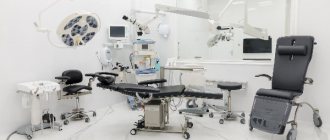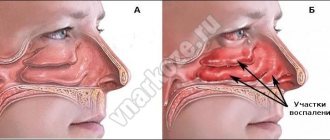Many people are afraid of anesthesia. And many are hesitant to undergo knee arthroscopy, being sure that it is performed under anesthesia. But if you understand the medical terminology, it turns out that this is not so. Intrigued? Well, then let's figure it out.
Looking in any dictionary of medical terms, you will read that anesthesia is a deliberate inhibition of the central nervous system (CNS), the purpose of which is to “disconnect” the patient from the feeling and awareness of pain impulses. That is, for example, the effect on the patient’s brain with special drugs. In this case, an artificial coma occurs, muscles relax, some reflexes turn off and pain sensitivity disappears.
Anesthesia involves completely putting a person to sleep in order to turn off the central nervous system. However, not every patient is put to sleep during arthroscopy. Anesthesia is used only in special cases. And most arthroscopic interventions are performed under local, spinal and conduction anesthesia. These types of pain relief do not require “switching off consciousness”, so they frighten patients less.
Why is anesthesia needed for knee arthroscopy?
Anesthesia is a general concept that refers to the process of suppressing pain sensitivity with the help of drugs. It is necessary to relieve a person from pain, stress and discomfort during surgery.
Anesthesiologists distinguish several types of anesthesia:
- General (anesthesia) - effects on the central nervous system, the brain and consciousness of a person. Anesthetics are administered intravenously or by inhalation, through a laryngeal tube or mask.
- Spinal and epidural - blockade of the nerve roots that innervate the lower extremities. Painkillers are injected into the spine, at the level of the spinal cord.
- Conductor (regional) - involves blocking the nerve trunks and nerve plexuses, which are located above the operation site. Arthroscopy usually involves blocking the femoral and sciatic nerves.
- Local (infiltration) - blockade of sensory receptors of peripheral nerves. It involves the infiltration of periarticular tissues with anesthetics, as well as their introduction into the joint cavity.
Different types of anesthesia differ in strength, degree of analgesic and muscle relaxant effect. When choosing an anesthesia method, a number of factors are taken into account: the patient’s age, his state of health, the presence of concomitant diseases, the degree of trauma and pain of arthroscopic intervention, etc.
When should cataract surgery be performed?
Radical treatment of cataracts is possible only surgically - the lens is removed and replaced with an artificial one. Modern technologies make it possible to perform the procedure without waiting for the cataract to mature, which allows you to preserve vision. Indications for surgery are the following factors:
- Intumescent cataract;
- Mature and overmature cataracts;
- Subluxation or complete dislocation of the lens;
- Presence of concomitant eye pathology;
- Persistent decrease in vision.
General rules of anesthesiology
Adequate pain relief is an important condition for restoring limb function after surgery. Therefore, certain requirements are imposed on anesthesia during arthroscopic operations.
The main ones:
- sufficient intraoperative pain relief;
- adequate pain relief in the early postoperative period;
- minimal impact on the muscle tone of the operated limb.
It is extremely important that the patient maintains muscle strength and muscle tone in the lower extremity after surgery. This is necessary for early loading of the leg (full or dosed). If muscle strength is maintained, the person begins to walk soon after surgery, which allows him to be discharged from the hospital faster.
Symptoms of cataracts
Symptoms depend on the stage of the disease. At the initial stage, there may not be any subjective manifestations. At the stage of immature cataracts, vision deterioration is observed. Patients may experience double vision, blurred images, and a yellow coloration. Sensitivity to bright light increases, while at the same time twilight vision decreases. Many patients use bright light to read or work with fine details. Myopia develops or progresses, which cannot be corrected with glasses. At the stage of mature cataract, all symptoms worsen, and at the stage of overmature cataract, complete blindness occurs, up to loss of light perception.
Features of different types of anesthesia
For intraoperative pain relief, various methods of general, regional and local anesthesia, as well as their combinations, are used. Each of them has a number of disadvantages and advantages.
Local
From a technical point of view, local anesthesia is the simplest. Even a traumatologist can perform local administration of anesthetics without the help of an anesthesiologist. However, such anesthesia does not always provide a sufficiently strong analgesic effect. And its quality largely depends on the practical skills of the traumatologist.
Conductor
It is one of the best options for pain relief during arthroscopic interventions on the knee joint. It is technically more complex than local, and therefore requires great skill of the anesthesiologist. The doctor must have a good knowledge of the structure of the peripheral nervous system, master the technique of blocking nerves at different levels, and be able to use special instruments to perform a femoral / sciatic nerve block.
Conduction anesthesia provides long-term pain relief during movement of the lower limb and thereby improves the course of the early postoperative period. However, due to technical difficulties, it is still less common than spinal.
Spinal
Guarantees adequate postoperative pain relief and early restoration of muscle tone. However, a number of complications can occur, including spinal cord or root injuries, radiculopathy, cauda equina syndrome, seizures, etc. The high incidence of side effects (back pain, headaches, hypotension) often reduces patient satisfaction with the quality of such pain relief.
Anesthesia
It is rarely used during arthroscopy, usually in one-day hospitals. Modern intravenous and/or inhalational anesthetics can be used for anesthesia. During surgery, the patient often breathes independently through a laryngeal mask. For special indications, he may undergo artificial pulmonary ventilation (ALV).
Anesthesia has its advantages:
- safety;
- good handling;
- minimal number of side effects;
- no effect on the muscle tone of the limb in the postoperative period;
- possibility of rapid discharge from hospital.
At the same time, anesthesia does not always provide adequate postoperative pain relief. Therefore, in the early stages after arthroscopy, the patient may be additionally administered anesthetics.
Operating principles
Anesthesia is carried out immediately before the start of treatment. The anesthetic comes in both liquid and gel form. The doctor injects into the soft tissues that are located near the diseased tooth. After some time, the tongue, gums and cheeks become numb and “freeze”. At this moment, the anesthetic acts as a blocker of nerve impulses that send a pain signal to the brain. The patient calmly endures dental procedures without experiencing stress.
The duration and effectiveness of dental anesthesia depends on the quality of the materials used and the location of the injection. The closer to the problem area the injection was administered, the more intense its effect. Each organism is individual, therefore the drug will be excreted at different rates.
Different types of drugs function in their own ways. For example, gel-like ones applied to the gums or surface of the cheek last only a couple of minutes. If they are installed in the upper part of the jaw, the effect will last for 2-3 hours. To treat the lower group of teeth, a deeper injection is required, so the result lasts up to 4 hours. After the solution is absorbed, the numbness disappears and sensitivity returns to the patient.
Choosing a pain relief method
Today, most arthroscopic interventions are performed under spinal anesthesia. For short-term operations, a 2% lidocaine solution is injected into the patient's subarachnoid space. For arthroscopy lasting more than 1.5 hours, a 0.5% solution of isobaric or hyperbaric spinal marcaine is used. Note that spinal anesthesia can cause hemodynamic complications if the patient is hypovolemic. Therefore, in gerontological patients, an epidural is often used instead.
In recent years, diagnostic and therapeutic arthroscopy has increasingly been performed under general anesthesia. It is less expensive, less likely to cause side effects, and produces greater satisfaction among patients and trauma surgeons.
In emotionally labile patients, intravenous anesthesia with mechanical ventilation or spontaneous breathing through a laryngeal mask is often used.
Local anesthesia is used only for low-pain arthroscopic interventions, for example, when removing foreign bodies from the joint cavity. “Classical” anesthesia with intubation and muscle relaxation is also used extremely rarely, only if there are special indications.
Cataract treatment
In the early stages, conservative treatment is carried out using drugs in the form of drops to restrain the progression of the process. The drops contain substances that either increase the energy level of functioning of the lens structures or protect them from the harmful effects of products of impaired metabolism of amino acids such as tryptophan and tyrosine. However, the main method of treatment remains surgical. Extraction (or extraction) of the cloudy lens from the eye cavity. Today, the optimal operation is cataract extraction through a small (from 1.5 to 3.5 mm) incision with simultaneous implantation of a foldable IOL (intraocular lens) made of a hydrophobic polymer material with shape memory into the capsular bag of the lens. Ultrasound energy is used in combination with the impact of a sound wave to destroy the nucleus of the lens. Make an appointment
Contraindications
The greatest number of contraindications exist for general anesthesia. When administered systemically, anesthetic drugs can negatively affect internal organs. Therefore, anesthesia is contraindicated for arrhythmias, heart defects, bronchial asthma, bleeding disorders, renal, hepatic and cardiovascular failure.
Contraindications to spinal and epidural anesthesia may include infection at the injection site and allergy to anesthetics. These types of pain relief will not be used even if there are no contraindications. This is possible if the patient himself refuses them.
What happens if cataracts are not treated?
Cataracts will inevitably progress, even with the use of the most modern medications. Degenerative processes will lead to disruption of the structure of the lens, its clouding and delamination. Eventually, the cataract will enter an overripe stage, when the fibers of the lens disintegrate, its cortex liquefies, the nucleus loses support and sinks down. The result is complete blindness. In addition, complications are possible, for example, the development of glaucoma due to occlusion of the outflow tract of intraocular fluid, or rupture of the lens capsule and release of detritus with the development of the inflammatory process.
What complications can occur after cataract surgery?
Complications after surgery can vary and depend on how thoroughly the patient prepared for cataract removal. That is why we ask for a wide range of tests and expert opinions so as not to miss an alarm signal and minimize complications. It also directly depends on the preparation for the operation - whether the patient has followed all the recommendations. And from maintaining hygiene after replacing the lens. If the patient has completed all the preparatory steps and doctor’s prescriptions, there are usually no complications and the results of the operation are pleasing to the patient, his family and us.
Takhchidi H.P. et al. Intraocular correction in surgery of complicated cataracts. – M.: Publishing house “New in Medicine”, 2004.
Khodzhaev N.S. Cataract surgery using small incisions: clinical and theoretical justification: Dis. ...Dr. med. nauk.- M., 2000.
What tests need to be taken before lens replacement surgery? Which doctors should I go to?
Before the operation we require without fail:
- Complete blood count + ESR + platelets. Valid for 10 days.
- Blood sugar. Valid for 10 days.
- RW (syphilis). Valid for 1 month.
- Hepatitis B and C. Expiration date: 3 months.
- HIV. Valid for 3 months.
- Fluorography (x-ray of the lungs). Valid for 1 year.
- ECG. Valid for 1 month.
- Dentist consultation. Valid for 1 month.
- ENT consultation. Valid for 1 month.10.
- Consultation with a therapist. Valid for 1 month.
- If you have a history of diabetes mellitus, consult an endocrinologist. Valid for 1 month.
Why so many tests?











